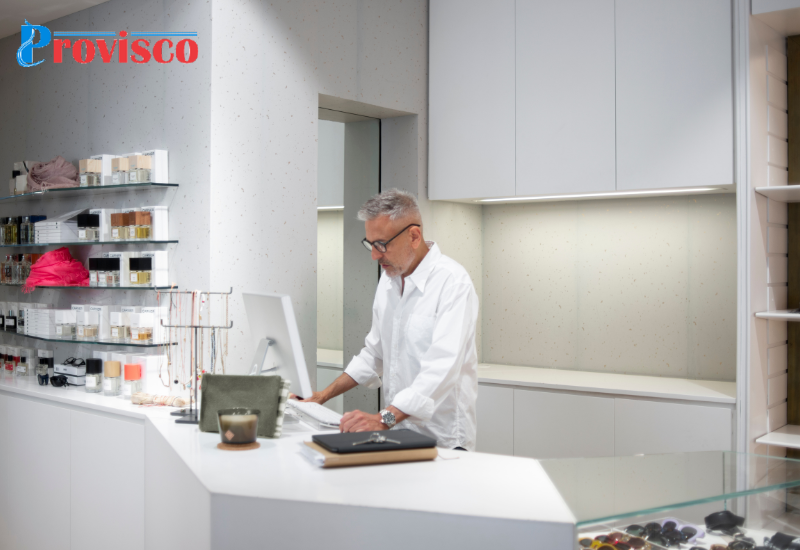A Laboratory is entirely committed to the execution of experiments, research, data collection, and sample testing. The laboratory is the soul of every thriving technology and innovation. When a lab is meticulously designed we can say that half the battle is won. Here we have addressed some factors that can optimize lab layout.
Organization
The laboratory must be well organized. For this, it is necessary to place tools and equipment in specific areas. This is accomplished by task cluttering, in which all items belonging to the same category are tagged and stored together. Unwanted equipment is stowed away, maximizing space.
Proximity of items
According to one study, precious hours of productivity are lost at work when looking for items. With proper planning and minimal effort, this is easily preventable. Everyday necessities should be kept near the counters for easy access and to prevent user strain. Proper countertops with built-up storage can take care of this.
Ventilation
Chemicals and dangerous materials are stored in laboratories. Proper ventilation Is required to eliminate dangerous gasses and pollutants from the laboratory and to circulate fresh air in the workspace. This is crucial for the health of working staff and increasing productivity. Selecting an applicable fume hood and placing it in the proper location is important. A variety of fume hoods in terms of compatibility, filter system, and current versions are available to meet customer specifications.
Safety
When it comes to lab layout the safety of researchers is primary. There should be an emergency exit route as a safety measure in case of an unwarranted crisis. Biosafety cabinets, an eye wash station, a shower fire extinguisher, and detectors must be placed in the hall near the entrance. Gowns, masks, gloves. goggles should be provided to staff as a safety barrier. All this will ensure that they are safe and in case of mishaps, they can protect themselves.
Ergonomics
Laboratories are environments where individuals spend many hours conducting repetitive and demanding tasks. It is safe to state that persons working in poorly equipped labs are exposed to a myriad of ergonomic dangers owing to the nature of their job and research. Thanks to innovation. Adjustable chairs, benches, and tables are available to serve the users. Ergonomic furniture is flexible and user-friendly. You can sit comfortably for long hours without strain on your neck or back.
Flexibility and scope for expansion
Researchers can receive faster findings with flexible lab space, in part because they can start new investigations without having to wait for costly modifications. More adaptable design can also assist businesses in navigating the current scarcity of adequate lab space in many markets. As a bonus, lab areas that can be rearranged on demand promote greater involvement and collaboration among researchers and make a facility more appealing to talent.
Changes in design and configuration are allowing scientists to transform lab spaces to meet their needs and easily move heavy equipment, Humphrey explains.
Waste Management
Try to recycle and reuse as many materials as possible. The containers which are not used must be stowed away. All dangerous waste must be stored in appropriate containers with adequate labeling. Laboratory waste can be disposed of in recycling, trash, glassware disposal boxes, sharp containers, or regulated medical waste boxes. All these measures are crucial for a clean and sterile lab environment
Aesthetics
A well-designed and visually appealing lab can work wonders. This can boost the morale of working staff and enhance productivity. Stylish and comfortable chairs, desks, and tables can be set up. Incorporate natural lighting to create a pleasant environment.
Bottomline
The laboratory is committed to the execution of experiments and research. data collection and sample testing. The laboratory is the soul of thriving industrial sectors. Many factors play crucial roles in the process of lab optimization. This includes proper organization, ventilation, safety standards, ergonomics, flexibility, waste management, and aesthetics. When all these factors are addressed, it will enhance productivity and lab efficiency.
Related Questions
1. How is the laboratory cleaned?
All kinds of grease and soil can be removed by using laboratory cleaning products and ultrasonic products. While other processes require sterilization to kill the microorganisms.
2. What are the principles of laboratory safety?
Follow all the instructions, wear safety gear, avoid skin and eye contact with chemicals, minimize chemical exposure, and keep a chemical inventory list, all equipment should be regularly inspected for wear or deterioration.
3. What is lab furniture made of?
A variety of steel such as stainless steel is commonly used for lab cabinetry These steel components are heavy-duty and provide rigidity.


